Newsletter ** Privacy Contact Us ** About

Once more into the breach dear friends …
I’ve just completed my visit the 2019 Consumer Electronics Show in Las Vegas. It’s an annual pilgrimage I make to the Mecca of the digital device. I’ve attended the show for many years, and for the last half dozen have blogged about my experiences.

This year I was able to spend about a day and a half in the halls.
My write up this year is more verbose as I’m adding more depth in my interpretation of what I saw, and some predictions for the future.
Previous Years
If you care, here are links to my notes on the last half dozen or so years of the show:
2019 Show
I’ve been holding out from saying this, but I think CES is in danger of getting too big. Not just the overall volume of the show (yes, it’s huge), but the spread; it’s becoming too broad.

Many years ago, CES was “The Consumer Electronics Show”. We’d see the new TV’s, cellphones, laptops, BluRay, DVDs (remember those?), speakers, digital cameras, printers … Now it’s broadened into home appliances, robots, drones, 3D printers, cars, health, smart homes, and self-driving cars. Whilst you could probably (successfully) argue that these are still devices used by consumers, there’s such a diverse range of products that newer break-out shows, aligned with a more vertical focus, would benefit all.
There’s only so much a self-driving car has in common with an ovulation monitor.
As the show was so broad, I prioritized my time so that I didn’t have to spread myself too thin.
I breezed past the 3D printers, not because they are not cool, but because, as products, they are pretty mature, and time was short. Devices are available in all form factors and price, and using a wide array of media (including chocolate). As it’s hard to appreciate the subtle differences between the different devices, it was the variety and quality of each booth’s pre-printed samples that was the eye-candy bringing you to one stand or another.
I didn’t pay much attention to the electric scooters either.
Health
I walked, quickly, through most of the health section as well. If you can measure it, there were half a dozen connected devices on display to do it: Weight, temperature, sleep patterns, pulse, blood pressure, blood sugar, oxygen concentration …
There were connected yoga mats, smart shirts and socks, fitness companions, exercise machines, wrist bands, treadmills and, of course, massage chairs … lots of massage chairs.
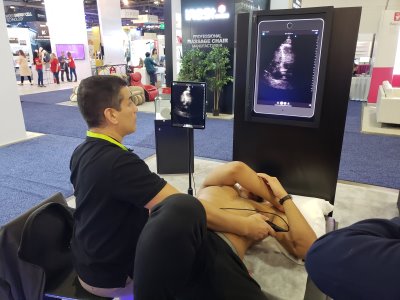
There were devices to predict perfect ovulation time for women as well as home devices to test male sperm (To quote from their marketing material “Test your swimmers in the privacy of your own home”).
I’m all for using technology to assist with attaining and maintaining a healthy lifestyle, but I think we’re in danger of this getting to neurotic levels. One device that caught me eye as just a bit too far was a personal ultra-sound device. Plug it into your tablet, slather yourself with gel, and you too can look inside your own body! Why? What part of this is a consumer product?
Does the average person on the street have any idea about what they are looking at in an ultrasound?, or how to interpret what they see?, or if there is a problem? Sure, I can see this device being useful to medical professionals, and a low cost device enabling a general practitioner to make an initial diagnosis without the need for a specialist, but I can’t see the utility of this device to the average Roomba consumer.
There were a plethora of baby monitors (both passive and active to detect breathing), connected breast pumps, and urine analyzers (it would not surprise me if these are now being built into these smart toilets).
I, actually, walked straight past most of the smart toilets, but I couldn’t avoid reading the claim of one manufacture extolling the “smartness” of their (heated) toilet seat. They said that said it was sophisticated enough to detect when someone was not sitting on it, and then powering down the seat to save energy!!! First of all, wow, how hard is to detect that a 100lb+ mass is not sitting on it, second, did your earlier models seriously continuously power the heater? (What a waste), and third, unless you live in Siberia, and have an outside toilet, do you really need a heated seat?
Lots of smart bike helmets too with integrated turn signals, lights, bluetooth integration …
Smart Home
Another section I casually passed through was the smart home section. It’s no surprise that there’s no shortage of smart switches, bulbs, door locks, garage door openers, fans, thermostats, colored LED lights, doorbells, pet monitors … all ready to connect and share data with your smart home.

As regards digital assistants to help control these devices, it’s a two horse race if presence at CES is the metric: Google Assistant, and Amazon Alexa. I think I heard the word Bixby mentioned once at the show (Samsung’s offering), but not a single utterance of Cortana (Microsoft), or Siri (Apple).
As regards branding, Google certainly won the battle at show from a visibility perspective. Their branding was everywhere, as were their embedded employees scattered through the show floor on partners’ booths, all wearing “Hey Google” coveralls, and bobble hats.

Show Quotes
A couple of memorable quotes from the show this year. The first was from Gary Shapiro, the President and CEO of the Consumer Technology Association (CTA). “The technology exhibited here today will do far more than just make our lives easier and more enjoyable – it will change the way the World works”.
The second was from keynote speaker Ginni Rometty, IBM Chair, President and CEO. ”For years I have said that data will be the World’s greatest natural resource” (I can’t argue with this as a Data Scientist and Knowledge Worker), but then she went on to say that ”We estimate that less than one percent of the data that the World is emitting is actually collected and analyzed”.
“We estimate that less than one percent of the data that the World is emitting is actually collected and analyzed”
Automobiles
The automobile technology, this year, filled the entire North Hall (not including all the self-driving demos in the areas outside).

This North hall was an eclectic mixture of LIDAR manufacturers displaying their devices next to Sub-Woofer and amp vendors (with their thumbing basses and flashing lights), with both of these being interstitially packed between larger booths for the car manufacturers (folks like Audi, Kia, Mercedes Benz …) Noticeably absent this year were replacement head unit manufacturers (in dash radios/changers/MP3 players). Replacement head units have joined the ever increasing pile of obsolete technology. Cars today interface to our smart phones, and the UI for all this is now all baked in by the manufacturer. Once you have Android Auto/Google Carplay in your dash, that’s all you’re ever going to need.
“The auto industry is going to change more in the next half dozen years than it has in the last half a century”
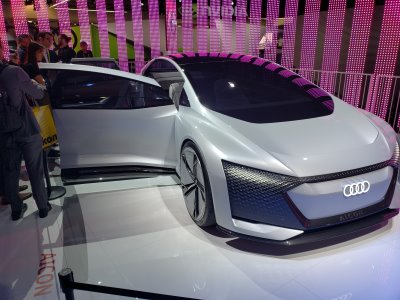
I think it’s fair guess to say that we’ve probably reached peak car ownership in the USA. Individual ownership rates will fall from this point out. There will be less and less need for personal car ownership (especially in inner cities). On-demand ride sharing services will pick up the load; you’ll summon a vehicle when you need a trip. Requesting a car only when needed is cheaper than owning, insuring, and maintaining your own car (unless you are a heavy user), and there is no hassle about trying to park it when you get to your destination. At the current time, there’s a warm uber/lyft pilot in the vehicle driving, but we all know this is a stepping stone, and it’s not going to be long before the driver is replaced and these summoned vehicles will be autonomous.
Providers like Amazon, and other online stores will deliver our bulk needs, products, toys, and consumables, so the justification of owning a car for the shopping run evaporates. And, for the those occasional longer trips, or that special event, you will still be able to rent. Why own a car if it’s going to spend 90% of the time in your garage not being driven?
Evolution of the Car
As the requirements for personal transportation change, so will the priorities of function. Form follows function.

Currently, cars are optimized for the driver; they are optimized for his/her convenience and needs. Dashboards and controls are now peaking at maximum functionality. The dashboards at the show on the high end cars were like mission control panels; acres of glass showing everything the driver could wish for in beautiful ergonomics. They were works of art like the controls of the Starship Enterprise.
However, once the driver no longer needs to drive, there is no need to give them information they no longer need. Dashboards will become simpler and revert to cleaner media displays giving entertainment options instead of control options. Less required switch gear will declutter panels, and interiors will become more sparse and artistic.
Demonstration vehicles at the show looked like the interiors of IKEA showrooms. Fully autonomous cars will not need steering wheels.
If you’re no longer going to be the owner of the vehicle you travel in, there will be no need to have glove boxes, cubby holes, pockets, bins or receptacles for you to store away the chattels you typically sequester in your family car. Interiors will become more spacious open and uncluttered.
Even the shapes of cars will change. Again, form follows function. Current vehicle shapes are both sleek and sexy to look at (who wants to buy and own an ugly car, when you can have a sleek looking car?)
However, if you’re not owning it, and are simply using it as a rented temporary transportation device, why do you care what it looks like? (When was the last time you didn’t get on a train because you didn’t like the way it looked?)
A current car is optimized based on the passenger bubble, driver placement, engine placement, as well as aesthetics. However, for an autonomous vehicle, it’s optimal to mount the LIDAR sensors and cameras as high up as possible on the vehicle frame to get the longest possible view and range of the sensors. Vehicles will become more box shaped. There’s no engine up front, so there’s no need for a hood; the windscreen will become more vertical and mounted further forward. The main cargo carrying will happen inside the passenger compartment, so there’s no need for a trunk (when you summon a pod, you’ll carry your wares directly inside, like you do when getting on a bus or train). Aerodynamics will prevent them from looking like total bricks, and soften and taper their edges (especially at the rear), but the low center of gravity (provided by the under floor mounted battery packs), no need for transmission tunnels with electric motors mounted directly in the wheels, and the high roof mounted sensors will create a neat high-volume box that the passengers can occupy, in comfort, on the trip.
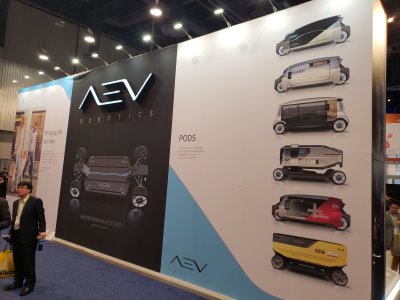
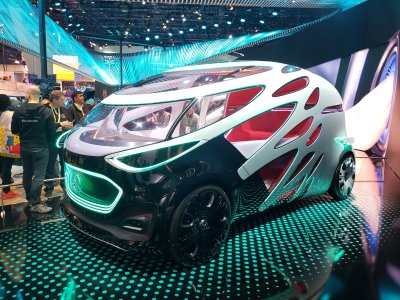
Supercomputers on Wheels
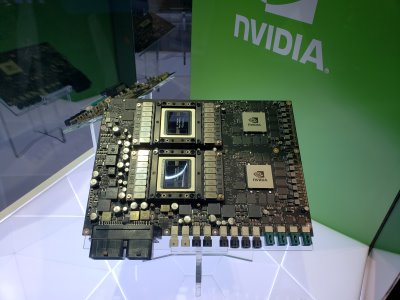
All of this autonomy will require massive amounts of processing power. Future autonomous vehicles will be powered by the equivalent of what we consider supercomputers today. The effects of Moore’s Law are still with us. Every year the processing need increases as more (and better) sensors are added to make cars safer. Here’s picture of one of nVidias latest boards. This time next year, these devices will be even more powerful
Already performance is measured in the hundreds of Trillions of deep learning operations per second (think of this like a couple of hundred MaBook Pros!)
People as Passengers, not drivers
So is this the death of the car as we know it? Not quite, there will still be cars made for enthusiastic drivers; Those people who have a passion for cars, but it will become more a niche market. These high-end cars will be mechanical works of art. Today, people buy exquisite hand-made Swiss wrist watches with their intricate mechanisms, even though they are based on centuries old technology. These watches cost thousands of times the price of a simple quartz analog watch (which probably keeps more accurate time), but that doesn’t matter, as there is pride in ownership. The likes of Ferrari will continue to make magnificent feats of engineering, and people will buy them.
Driving is also fun, so cars will also still be made as recreational vehicles. Driving will become a sport, not a necessity.
Autonomous Delivery

There was a demonstration Postmates van on display. Think of this like a self-driving Amazon locker. When you buy anything online, it’s pretty much the fabled “last mile” of the delivery that is the most costly: The bit that requires a warm body to drive down your individual street, stop, get out, pick up the package, put it on your doorstep, then wash-rinse-repeat, until they’ve worked eight hours, then go home. If you could put the package inside a locker on a van, then autonomously drive this van to the delivery address, and page the recipient to get out and collect it, you’ve removed the warm body from the equation (and also can deliver around the clock). Everyone wins.
Why an autonomous delivery van and not a delivery drone? I’m not saying that drone delivery will not eventually happen for urgent requests (or light weight items like medications), but it’s just too inefficient (and unsafe) for most things. Why the heck would you use a flying drone to deliver 50lbs of cat litter (and it would be pretty hairy to think of this flying through the air at 60 mph), a new food processor, and two gallons of bleach, when these items can be trundled safely, and efficiently, down the road in a delivery pod?
Batteries and Motors
It’s no secret, but electric vehicles need charging. The amount of energy stored in a fully charged electric vehicle batteries is staggering. Dangerously staggering. You can’t argue with the principles of conservation of energy; all the energy you put in eventually gets turned into heat (hopefully through an intermediate form of kinetic energy). All the joules you put in will eventually come out (sometimes sooner than later). In a crash, this time period could be very short.
Thankfully electric vehicles are very safe, and statistics show far safer than internal combustion engines (which carry dozens of gallons of very volatile gasoline in their tanks), and rarely catch fire, but when they do, they can be pretty vicious. A shorted out battery can melt thick metal in seconds, and generate so much heat that the batteries can literally explode. If the batteries contain fluid, this heat can cause rapid expansion to gas, increasing the detonation. There’s improvement that can be made in made in solid state batteries. I recall a rare event I saw of a Tesla burning by the side of the road on a trip to the airport. The fire fighters were on scene dousing the vehicle, and keeping it under control, but an hour or so later, when I returned back the other way, they were still there, and the car was still smoldering!
TVs
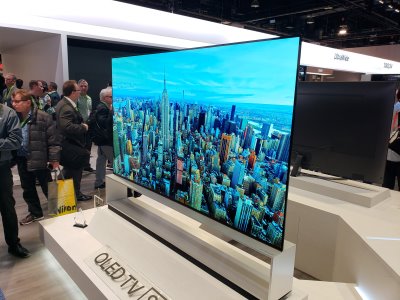
It would not be CES without big TVs. Period.
This year did not disappoint. Everyone was showing 8k devices (suitably ahead of the curve as retail stores are just spinning up to sell 4k). All the 8k TVs were fabulously brilliant to look at (and why wouldn’t they be? They’ve been tweaked, calibrated, setup, and fed native content with the sole purpose of wowing at this show). Yes, they were all stunning.
As they were all on different booths, there was no way to do any side-by-side comparison, but if you purchased any of them, based on what I saw, you would not experience any buyer’s regret
LG were showing a screen that could be rolled up and down to be stored in a box when not in use? Why? Sure, it’s incredibly cool, and massively clever, but outside of the geek engineering, it does not solve any practical purpose. It’s not like current flat panel TV’s take up valuable space in a house! Quite the opposite in fact; Flat TV’s are a couple of inches thick, and hung on wall, not getting in the way! Not since that days of gigantic CRTs and rear projectors, have TV’s been pieces of furniture and messed up the flow of rooms. Now with this toaster-like screen, it’s back to being a piece of furniture again (and you’ll have to feed cables to it that you can’t bury in the wall). Sure, buy one if you want to show off (they really are elegant), but I’ll stick to my wall mounted TV.
(I also worry about mechanical sympathy. Why force something to bend, when it doesn’t need to? It’s got to have a shorter mechanical life than something that stays the same shape all the time).
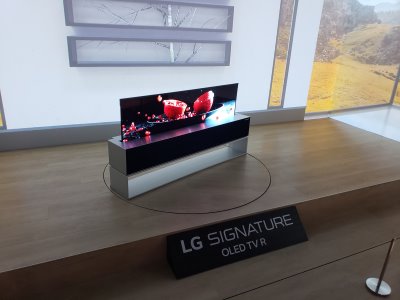
There were also some very nice (and very wide) curved UHD monitors for those people who just can’t get enough desktop in their lives.
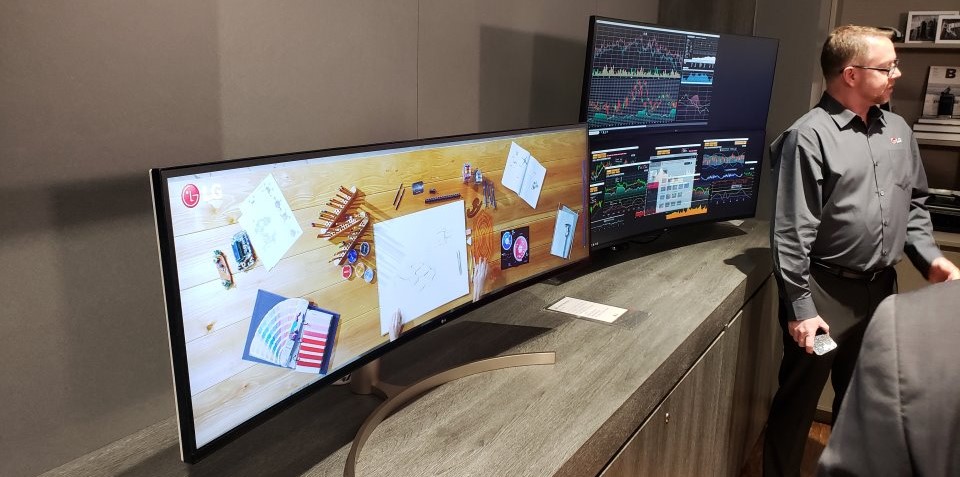
The most impressive display I saw at the show was Samsung’s The Wall. This was an incredibly bright, incredibly high contrast, video wall made from seamlessly connected tiles of microLEDs. It was displaying fabulous content. It was mesmerizing to watch; so much so that I had to watch the demo loop a couple of times. I tried to take a photo of the display to share but nothing I was able to capture in the crowd did it justice, so simply take my word for it!
All the 8k TV’s appeared to be displaying 8k native content. Sharp had an 8k video camera on display feeding one of their TVs (I didn’t have the heart to ask how much it might cost retail, but I did inquire on the Canon booth about one of their nice 4k devices, and was told it retails around $37k).
Drones
As expected, there were a lot of drones, and multi-copters on display. Some of them particularly large. I don’t know why, but it seems that nobody has been telling the large drone manufacturers about physics or aerodynamics. They are designing them all wrong. It bothers me.

Small and medium sized drones are typically quad-copters. This is appropriate. The four (fixed-pitch) propellers are electrically driven, and modern gyroscopes/control circuitry can dynamically balance the craft with subtle tweaks to the speed of each rotor. There’s very little mechanical complexity and this works fine. So far so good.
However, as the drone increases in mass, things don’t scale. Bigger propellers are needed to provide the required thrust. Because these larger props are heavier and larger in diameter, they have considerably more rotational inertia, and it becomes harder to finely control their speeds. It soon becomes impossible to achieve satisfactory stability. The result is that larger drones scale up by increasing the number of motors, rather than increasing the diameter of the propellers. I’m sure you’ve seen hex-copters with six fans, and octo-copters, with eight. Then they double them up-down below for twice as many! This is madness, and very inefficient. When was the last time you saw a 737 with a dozen engines?

Eight propellers requires eight motors. From a pure weight perspective, this is inefficient. One large motor will weigh far less than the combined weight of eight smaller motors.

Then there is the excess structural mass needed for the booms, and the fact that circular disks don’t tessellate, so even to get the same swept area as a single disk, the support structure needs to be larger. Have you seen those crazy large scale drone prototypes that have latticeworks of dozens of rotors with the aim of providing human capable flight? Utter lunacy! They are much heavier than they need to be, will have less range, and are less efficient. They are fantastic mad science contraptions, but not practical. There’s a reason helicopters are designed the way they are.
Helicopters are aerodynamically efficient. They use one disk*, and have a single central powered shaft. Yes, the central hub does need to be more complex because it needs to adjust overall pitch (collective) to adjust thrust (we’ve seen that inertial doesn’t allow for easy speed changes), as well as cyclic to steer. The complex mechanics required for a hub is why small drones use simple fixed pitch fans, but once you’ve gone above a couple of Kg of mass, a single hub is better. Also, structurally, a single hub is better as you don’t need multiple boom arms, each stressed to carry a percentage of the weight away from the center of mass.
*Unless they get really, really large and have tip speed limits, or material limits.
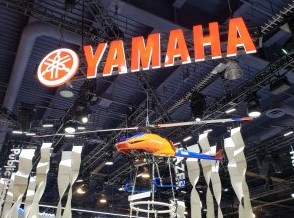
Efficient large scale drones are going to be configured like helicopters. Physics tells us this; stop the nonsense with these devices with dozens of motors!
I was going to say that everyone at the show has got this wrong, but then I saw this device from Yamaha. Well done. A large drone that (finally) looks like a helicopter.
In the interests of fairness, I have to confess that, for a simple helicopter design with a main motor and a tail rotor, there is a slight loss of efficiency as 10-15% of the main power is needed to drive the tail rotor to counteract the torque of the main rotor; this power is ‘wasted’ as it’s being used to keep the aircraft pointing in the right direction instead of providing vertical thrust. However, this loss is significantly smaller than the inefficiencies of multi-copters described above. It can also be addressed by making the main rotor a coaxial contra-rotating pair of disks (as seen on various military helicopters).
A single rotor system also doesn’t have the redundancy of multiple motors and can thus suffer from a single engine failure causing total power loss. However, auto-rotative rejection and using the energy stored in the large spinning rotor can help mitigate this worry.
If I had a crystal ball, I’d predict that large delivery drones in the future will have a pair of large contra-rotating disks like military helicopters.

Digital Cameras
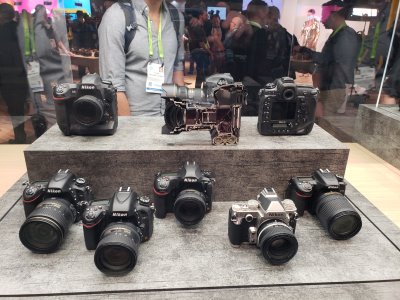
I’m I the only person who thinks it a little ironic that Polaroid had a selfie station on their booth encouraging people to take a picture there and posting it to Instagram for a chance to win a Polaroid camera?

Good, but Sad
In the category of clever technology seen, but I wish we didn’t need, was the gun shot detector.
This smart device comprises a sensitive microphone, an infra-red sensor, and micro-controller with an uplink. It continuously listens for suspicious sounds, and if it detects anything above a certain threshold, uploads the data to the cloud where the patterns can be identified. False alarms (like balloons popping, or cars backfiring), can be eliminated, and gun fire signatures (shotgun, rifle, handgun …) can be identified. A positive identification can trigger escalations and appropriate responses in seconds, potentially saving lives. The low cost of the devices (the processing happening on the cloud), means they are cheap to produce. The only potential issue is the vulnerability if the uplink does down.
A constellation of these devices in public places could make a huge difference in response times. I really, really, really, wish we did not have a need for this technology.
Best of Show
My pick of the show was a collection of pieces of tech; well thought out, and well presented (explained eloquently, and without selling), and also helpful to the planet. I wish them all the success I can.
As our cars are busy destroying the planet with carbon emissions, it’s not just CO2, NO2 pollution (the exhaust gas emissions) we need to worry about. Cars create lots of other pollution in the form of particulates. Rubber from our tires is scrubbed off each time we drive. Dust from brake pads and disks is generated each time we slow down.
Sure, electric cars don’t have internal combustion engines so they don’t contribute (directly) to exhaust gas emissions, but with their battery packs they tend to be heavier than IC cars, so wear out tires faster (though with regenerative braking, they will generate less mechanic disk pollution).
Fine Dust Eaters
Fine rubber particles, brake dust, and abraded road surface are not healthy to breathe. (Neither is smoke!)
Mann+Hummel, has developed a series of ideas as “Fine Dust Eaters”. One idea is to capture brake dust directly from by the calipers to stop it entering the atmosphere. Another is like a giant hepa-filter (here mocked-up on top of the car) to filter air as the vehicle drives through it. Whilst this increases the drag, the increase in Carbon this additional drag creates, is compensated by the carbon and particulates it removes from the air as it drives. There’s some study that fitting larger devices to public transportation buses can make the efficiencies greater.
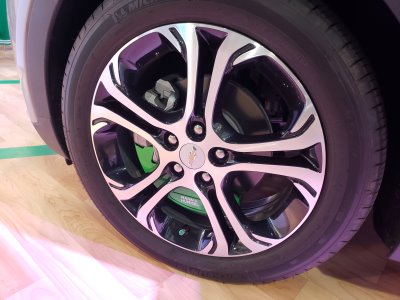
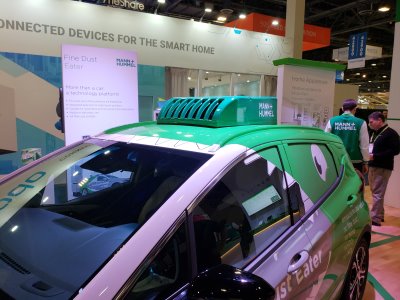
In Stuttgart, they are also running trials of street mounted Filter Cube devices that continuously filter the air. Already they are seeing 20% improvement in air quality where the devices are running.
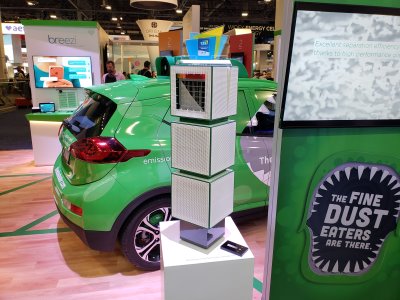
FLIR
Each year I look at the FLIR cameras (forward looking infra-red) and wish I could justify a purchase. These are thermography cameras that ‘see’ heat. They are such fun to play with. This year they had an HD one on display.


Seriously, they are really fun to play with as well has having hundreds of practical, and safety applications.
Hybrid Watches
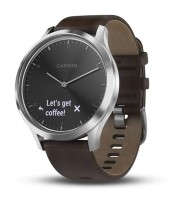
Quite a few manufacturers were displaying hybrid smart watches. These were mashups between traditional analog watches (quartz analog devices, with traditional hands), over LCD faceplates connected to smart inner workings.
The traditional analog hands give the watch all the aesthetics of a traditionally classy wristwatch (along with a couple of weeks of standby battery life), whilst the smart LCD back gives you the benefits of a smart watch (for a day, unless you remember to charge it).
If my current watch ever packs up, I think I’d seriously investigate getting some form of hybrid watch. I think these really are a great mashup idea, and inherit positive benefits from both sides.
5G
This is supposed to be the breakout year for 5G. A couple of devices at the show claimed to be 5G, so it has to be true!
5G stands for fifth-generation cellular wireless, and the initial standards for it were set at the end of 2017. This next generation offers the potential for massive increases in bandwidth (by two orders of magnitude), using millimeter wave radio signals at 39GHz (albeit over short ranges). There’s a lot of hype, and we’ll have to wait to see how quickly rollout happens, but if it’s all it promises to be, it could be the beginning of the end of requiring a cable connection.
There’s nothing to see or touch, so we’ll just have to wait.

If the 5g dream comes true, Gigabit connectivity will be all around us, just like oxygen.
“5G is digital oxygen” - Nick Berry, 2019
Blockchain
There was not as much over-hype about blockchain as I’d imagined there was going to be (nor cryptocurrency either). IBM, however, were there trying to explain how blockchain would add great value to the food supply industry to improve safety.
I’m all for improved food safety, but I have to think that blockchain is over the top and does not solve the part of the problem that is important. Sure, tracking is important, and giving each batch of produce a unique tracking GUID is a way to do this. Then, if there is any contamination, theft, or scare, it can be quickly identified. Fedex does this already with my parcels using a GUID and a simple database without blockchain. At anytime, I can go to the Fedex web site, type in the trackingID, and find out where my package is, can get an estimated delivery window and, if I care, a complete transaction log of every warehouse it’s been in and out of along its journey. Being able to do this with a carton of oranges would be just as useful, but it does not need the additional complexity of blockchain. A well written database can track all these things without having to propagate every transaction through a trusted ledger. Yes, for crypto currency, I’m concerned about integrity of the entire system, with full audit trails; yes please, blockchain the hell out of it. But I’m not worried about a malicious individual trying to take control of >50% of the ledger to steal a shipment of oranges.
If an airline loses your bag, it’s because they’ve lost your bag. It’s not that they don’t know the ID of the bag, or that it’s been changed; it’s because they can’t find it! Having all airline bags tracked through a secure blockchain ledger is all well and good, but that’s not the part that failed. The reason your bag got lost is (probably) because it fell off a cart, or get left in a corner somewhere, or most likely missed a connection. It’s not because some malicious individual tampered with a database. If the handler did not not scan the bag when it missed that connection, no database, blockchain or not, is going to be able to find it until it has been.
Miscellaneous
Here’s a collection of other miscellaneous things I encountered at the show:
Supersteam cooker
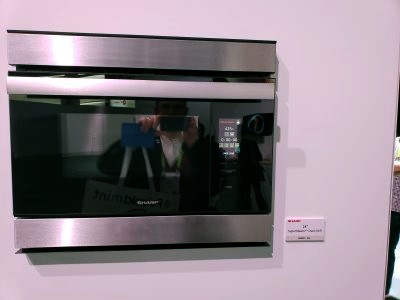
Sharp were showing a supersteam cooker. This uses super heated steam to cook food. I’m sure it is great for things like cake and vegetables to keep them moist, but when I cook meats, I want them to be roasted and browned; its the Maillard reactions that causes the browning and caramalization that builds all those tasty flavors. Instead of a supersteam cooker, a simple pressure cooker would be better? (but it’s not the right shape for flat cake?) Also I bet you have to use dionized water in this oven or, if in hard water areas, you’ll need to de-scale it regularly.
IBM quantum computer

IBM was proudly announcing: Q System 1. The first quantum computer you can buy on the market.
It looks beautiful and steampunk when you can see the inner workings. Sadly, when boxed up, you’ll not be able to see the polished brass, coils, and copper.
Ping-Ping Robot was back

The Ping-Pong robot was back from last year, and it appears to have been practicing as it seemed to have more l33t skilz than last year.
Square Off: Telerobotic Chess
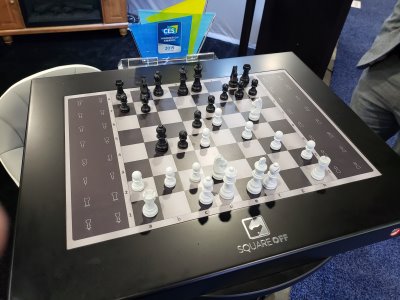
It’s not a massive leap to connecting two back-to-back to play over the Internet. The hard part is the mechanics, and that was solved three dozen years ago. I think it’s a little funny that the press release talks about this product as “The Harry Potter Chessboard”, when the original MB robot chess board sold decades before the Potter books were written.
Home biogas
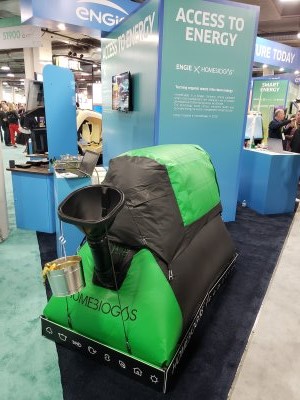
It’s pretty simple. A device to enable people to turn waste into renewable energy. Feed it your scraps and waste (this tent will take up to a dozen litres a day). Bacteria digest the scraps to make methane gas you can cook with (and makes liquid fertilizer as a by-product). It’s a circle of life thing!
Dubious things and pointless things
Walking around the show I encountered a collection of ‘dubious’ things. Dubious things are things that weren’t necessarily bad, but I don’t really get. Then, I encountered to some truly ‘pointless’ things. Here, in no particular order, is a collection of these. It goes without saying that the classification of ‘dubious’ and ‘pointless’ is my own personal opinion.
Dubious: RFID shoe closets
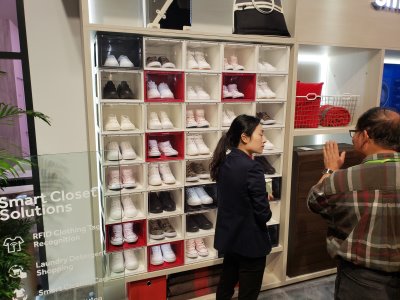
I can’t get my kids to pick up their shoes from the floor, I’m not sure adding RFID tags inside them will help them organize their closets more. If I put my shoes neatly away in my closet, I’m not going to need help in finding them again.
Dubious: Mashup between a snowmobile and a motorbike
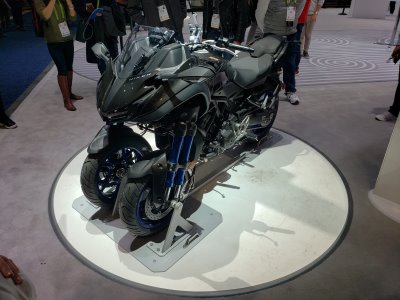
It certainly looks cool in a MadMax way, but are motorbikes really that unstable when you drive them that requires the extra stability of a double front wheel?
Dubious: Standing table pedal bike
Dubious: Connected smell generator

With this device you can use your smartphone to send a desired mix of smells into your living room.
Dubious: Mechanical Pong
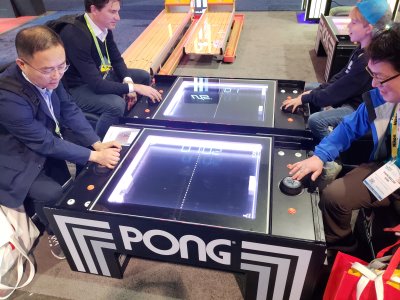
Wonderful pieces of engineering.
Dubious: Smart Tea Pot
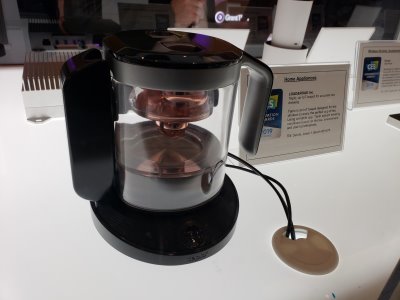
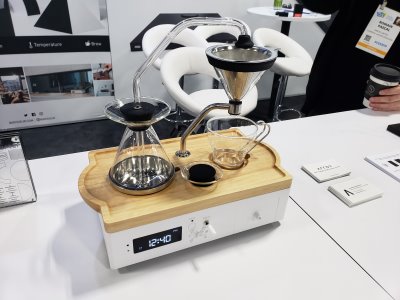
Even though I’m English, I don’t think I want this ‘smart’ connected teapot (Should I say it’s “I” “oh” “Tea”, you know IoT … I’ll get my coat).
I might, however, go for this coffee pot because it’s a work of art and looks like a chemistry lab experiment.
Pointless: Solar powered ceiling fan
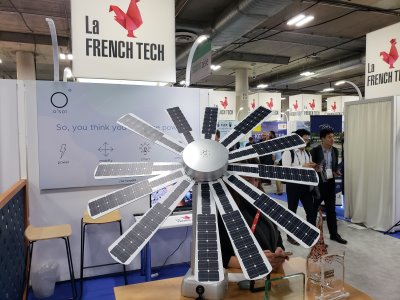
A solar powered ceiling fan is a fabulous idea to create breezes in hot regions, but my issue with this product is the design. If you look carefully you will see that the solar panels are mounted directly on the blades. This design shoots itself in the foot. A ceiling fan, by definition, is mounted close to the ceiling, and the ceiling will block the sun! A much better design would be to mount the solar panel external to the room, then run a wire to the fan mounted on the ceiling. If you are allowing direct sunlight to fall on the fan to make it turn, you’ve got bigger problems from the sun radiation energy; better to mount the fan in the shade.
Dubious: Tracking how much your car pees
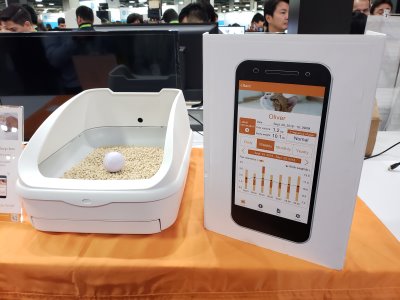
A device to measure, monitor, and record how much your cat pees, and compare it to historic data for trend analysis. (Providing, of course, that your cat pees in the litter box. If the little urchin pees on your bed, rug, or carpet, I guess you’ll miss that data point. I did not ask if there was a way to make manual adjustments or corrections). Receiving alerts on your phone will never be the same again.
Pointless: Mash-up blender
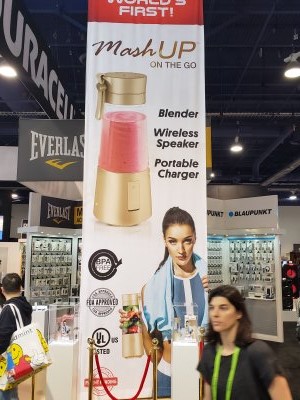
OK, here’s the “World’s First” (and only, and last?) mash-up between a blender, wireless speaker, and portable charger. Who comes up with these combinations, and what is the usage scenario? I pack my blender with fruit, and a some time later, whilst listening to music and charging my phone, decide to hit blend?
It’s FDA approved, UL listed, Patent Pending, and if someone asks you “Ah, but will it blend?” then you’ll be able to reply, truthfully, in the affirmative (but it’s probably not what they mean).
Dubious: Hand clapping robot
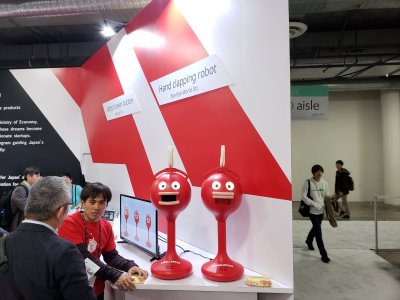
What does a hand clapping robot do? It claps hands. That’s it!
Pointless: Decorated VR turret
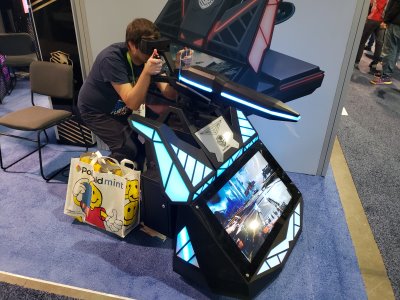
I guess it’s aesthetic for external viewers (though I’m not sure it’s a spectator sport), but if you’re playing a VR game shooting a gun from a turret, with your eyes flush against the mask, what the the point of all the flashy external lights and effects that you can’t see?
Dubious: Cardboard Vintage Camera

From Ukraine, we have the World’s first cardboard vintage camera. There are no other words needed. The title describes everything about the product.
Dubious: Peak Wall-E
Dubious: Play Smart Treat Cam

How do you integrate your pet into your smart home? One sad product was a “Play Smart Treat Cam”, that automatically feeds treats to your dogs to reward them for performing tricks to a robot. I’m sorry, but why bother getting a pet if you’re not going to interact with it yourself?
Pointless: Internet Fridges, Washing Machines, Dishwashers, toasters

If I physically need to put bread in the toaster, then take it out again, why do I need to control it with my smartphone?
Pointless: Single loaf, on demand, bread machine
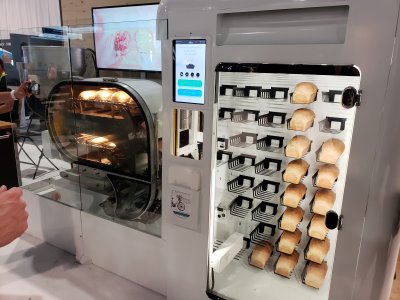
OK, this is a super impressive piece of technology as a project, and all guts were there on display so you could see the inner workings, but why? What problem does this solve? This device has to be inefficient for no perceived value. There’s a reason bakers batch-bake dozens of loaves at a time, rather than one at a time. It’s better use of energy. I could, potentially, see some value in a one-at-a-time, just in time bake, if the shelf life of a freshly baked loaf was measured in seconds, but it’s not; bread stays fresh at least as long until the next time a baker makes a batch.
You don’t make ice-cubes, one at a time, on demand. You shouldn’t do the same with bread.
Pointless: Assisted manual document retrieval
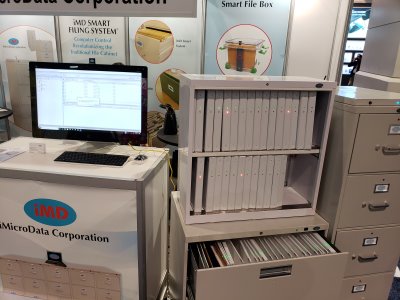
I’m not sure I get the utility of this. It’s a manual document retrieval helper. If you’re looking for a file, you enter details into a computer, then it lights up the file where it’s located. (I guess for people who can’t read words on spines). Since they are all manual, it’s only a good as the person who puts it in there. Pretty niche. The world is going electronic, and most places will now accept scanned documents and electronic copies, so this is already limited to potential legal use? Plus in order to search them you probably needed to scan them and create the meta data in the first place to create the index. Yesterday’s Future!
Pointless: Voice operated trash cans
Sadly, if you want one, it’s a proprietary unit, and you can’t connect it to your smart home. You can yell “Alexa, open the garbage bin” all you like and she’ll not be able to do that. The good news, however, from reading some of the web reviews of people who have one is that it’s not very discriminating, and will quite often open just by walking by it, or closing a door, or randomly talking to other people “Would you like to go for a walk?” or “I like peanuts” so even though it’s not connected to Alexa, if you’re in the kitchen and ask Alexa to tell you a joke, there’s a good chance the bin will open!
Hang on, I’m almost talking myself into one. Who doesn’t want a garbage can that erratically opens and closes to random conversations in the kitchen, and rewards you with the aroma of the contents …
… because, as their literature says it’s “the more efficient way to trash”!
Scariest Things
In the category of scariest things seen at the show we have, in first place, this flying contraption, ElectraFly. These guys strapped a small gas turbine (jet engine) to the bottom of a large eight fan multi-copter. It’s advertised as a personal flying machine. Differentiating it a little from just a scaled up drone is the gas turbine, giving a horizontal component of thrust, and the spars, having an aerodynamic wing cross-section, so, once moving forward, these will give lift, reducing the lift load needed by the electric propellers.
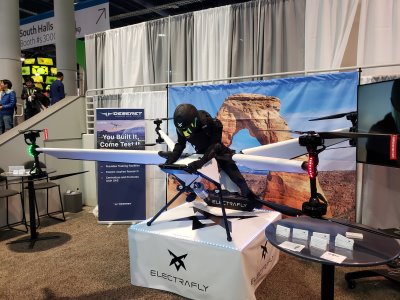
For the reasons mentioned in the Drone section above, these devices aren’t going to be efficient enough to get any more than a few minutes of flight time (about the same as what you can achieve with your battery drones now), and they will need to be moving forward for those wing sections to generate lift of off load the props. The little gas-turbine mounted on the bottom is going to make a scream of a lot of noise and drink fuel very quickly.
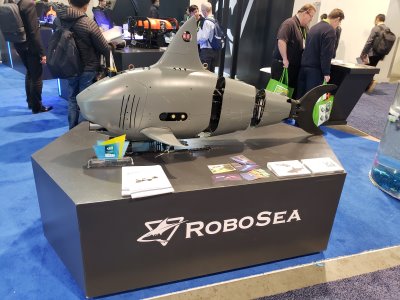
Thankfully, this robot shark did not have a fricking laser beam attached to its head.
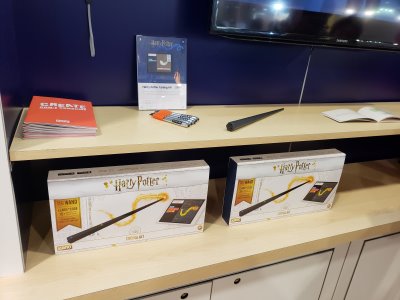
And finally, this Harry Potter wand programming kit for kids.
With all that silly wand waving, you’ll have someone’s eye out!
See you next year CES. It’s been as fun, and tiring, as ever.